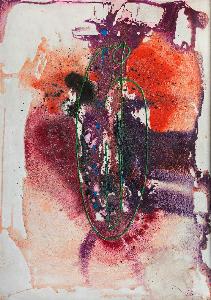Qutaiba Al-Sheikh Nouri
Qutaiba Al-Sheikh Nouri
Place: Baghdad
Born: 1942
Death: 2014
Biography:
Qutaiba Al-Sheikh Nouri was a renowned Iraqi artist born in Baghdad in 1942 and passed away in 2014. He is celebrated for his oil on board paintings, such as Patches of Blood (1972), which are part of the Iraqi art movement. This movement has a rich heritage dating back to ancient Mesopotamian periods, with Iraqi art flourishing during the Abbasid Caliphate.
Artistic Career and Style
Qutaiba Al-Sheikh Nouri's work is characterized by its unique blend of traditional and modern elements, reflecting his Iraqi heritage. His oil on board paintings often feature bold colors and intricate patterns, showcasing his skillful use of this medium. Patches of Blood (1972) is a notable example of his style, which explores themes of identity, culture, and history. Key Features of Qutaiba Al-Sheikh Nouri's Art:
- Use of oil on board as a primary medium
- Incorporation of traditional Iraqi elements and motifs
- Exploration of themes related to identity, culture, and history
- Bold and vibrant color palette
Contribution to the Iraqi Art Movement
Qutaiba Al-Sheikh Nouri's contributions to the Iraqi art movement are significant, with his work being part of a larger cultural and artistic heritage. The Iraqi art movement has a long history, dating back to ancient Mesopotamian periods, with notable periods of flourishing during the Abbasid Caliphate. However, it suffered during the Mongol invasions in the 13th century. Notable Iraqi Artists:
- Qutaiba Al-Sheikh Nouri: Known for his oil on board paintings
- Ali Jabbar: A sculptor exploring themes of identity and culture
Legacy and Recognition
Qutaiba Al-Sheikh Nouri's legacy is recognized through his inclusion in various art collections and exhibitions. His work can be found in the Sakıp Sabancı Museum (Istanbul, Türkiye) and other notable institutions. The Metropolitan Museum of Art, The British Museum, and The Louvre Museum also showcase Iraqi art, demonstrating the significance of this cultural heritage. Wikioo.org Resources:
- Oil paintings reproductions by category at Wikioo.org
- List of Artworks colors
- Qutaiba Al-Sheikh Nouri's profile on Wikioo.org
The Iraqi art movement, to which Qutaiba Al-Sheikh Nouri contributed, has had a profound influence on pan-Arab art. His work and that of other notable Iraqi artists continue to inspire and educate audiences worldwide. Through his oil on board paintings and contributions to the Iraqi art movement, Qutaiba Al-Sheikh Nouri's legacy endures as an important part of Middle Eastern cultural heritage.

